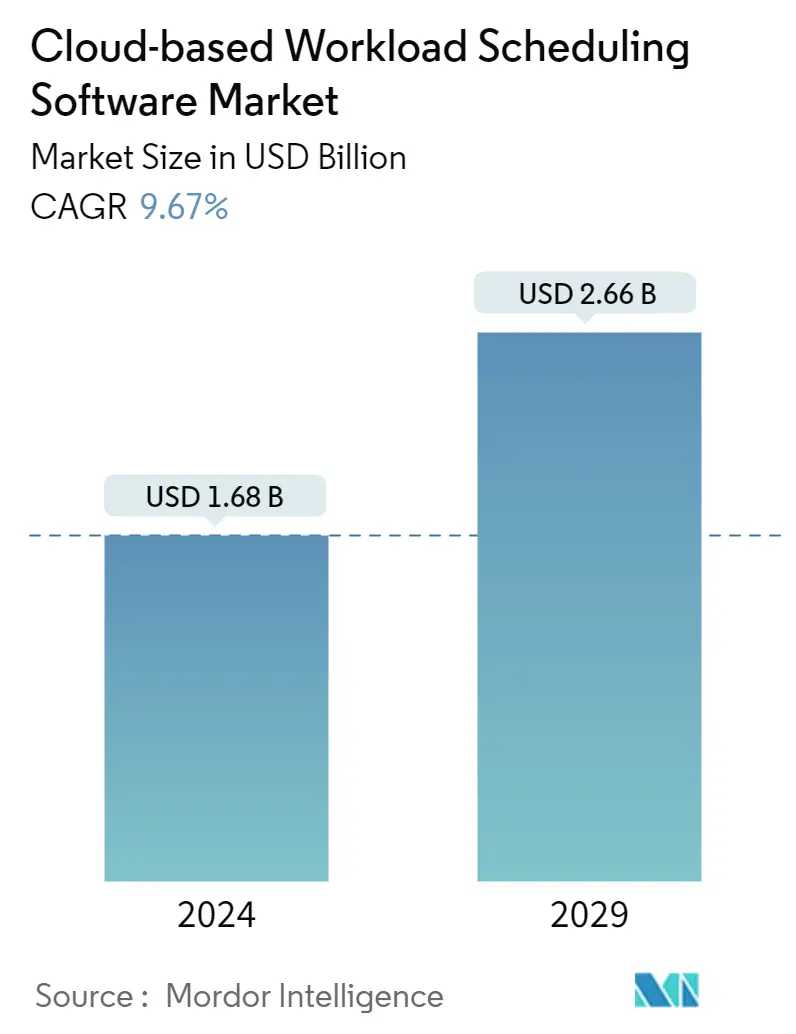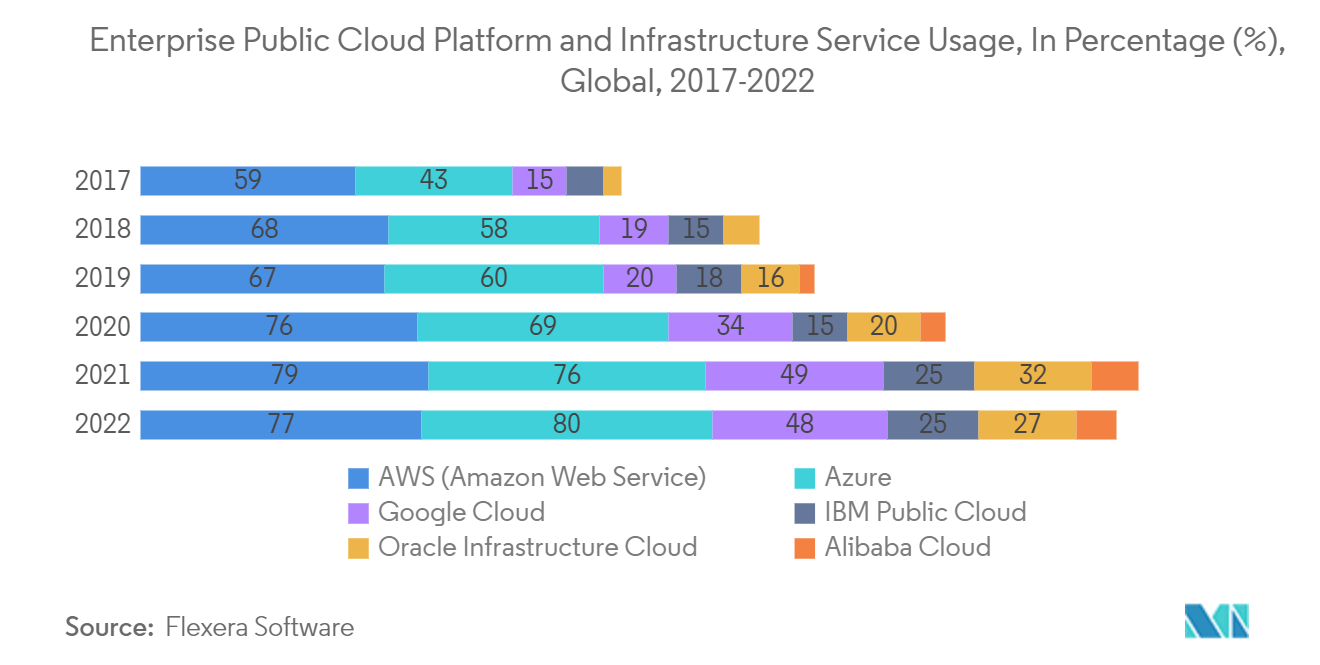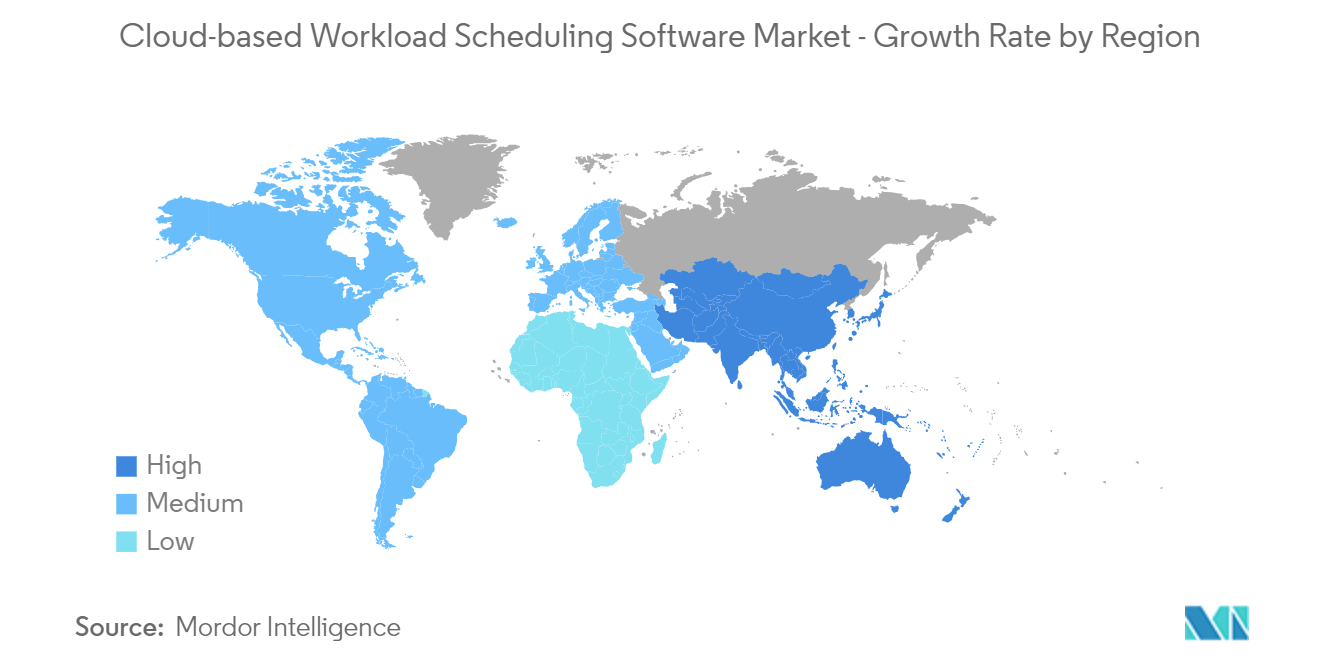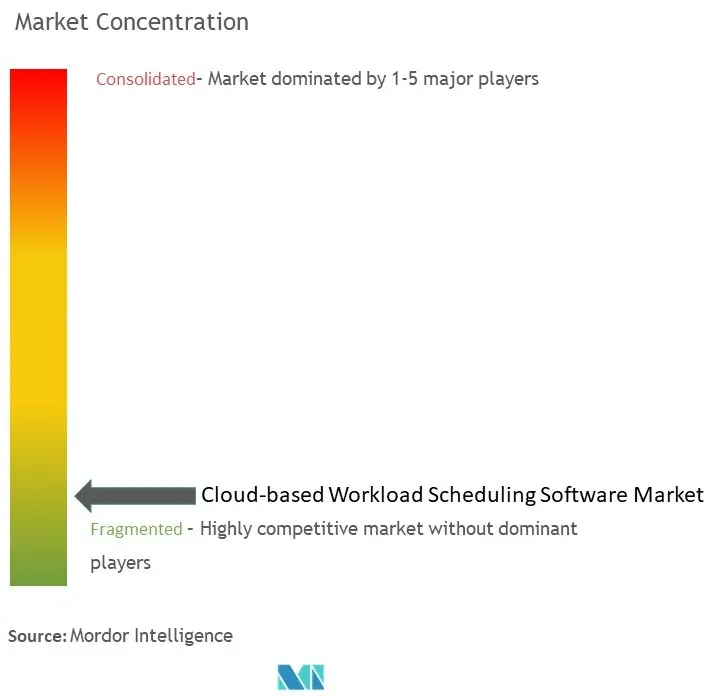Cloud Based Workload Scheduling Software Market Size

| Study Period | 2019-2029 |
| Market Size (2024) | USD 1.68 Billion |
| Market Size (2029) | USD 2.66 Billion |
| CAGR (2024 - 2029) | 9.67 % |
| Fastest Growing Market | Asia Pacific |
| Largest Market | North America |
Major Players
*Disclaimer: Major Players sorted in no particular order |
Cloud Based Workload Scheduling Software Market Analysis
The Cloud-based Workload Scheduling Software Market size is estimated at USD 1.68 billion in 2024, and is expected to reach USD 2.66 billion by 2029, growing at a CAGR of 9.67% during the forecast period (2024-2029).
As enterprises roll out new technologies, they need to consider and plan for impacts related to workload processing and the availability of critical applications across distributed and cloud environments; hence the need for better workload scheduling software is projected to increase in the future.
- The cloud-based workload scheduling software available can integrate, monitor, and operate workloads, perform analysis, and give predictions for the future. This empowers organizations with abilities to tackle problems that can arise in the future and also manage assets.
- Cloud-based workload scheduling software helps to improve workload scheduling without the need for human intervention. Sophisticated scheduling and analytical abilities help organizations increase employee efficiency. This is a significant drive for the cloud-based workload scheduling software.
- Similarly, the rapid adoption and increasing preference for cloud-based services by various multinational businesses would provide enough new opportunities, driving the expansion of the cloud-based workload scheduling software market during the forecasted period.
- However, the ease of availability, and the rapid growth of open-source software, are acting as major constraints for the growth of cloud-based workload scheduling software. The growing need to meet strict compliance and regulations has the potential to challenge the growth of cloud-based workload scheduling software.
- During the pandemic, many countries across the globe mandated work from home based on public health safety concerns that drove the need for remote working infrastructure. Therefore, organizations operating at all levels, including government bodies, expected a wide range of potential impacts, such as increased demand for virtual services coupled with rising citizen expectations around the delivery of these services, the longer-term potential for reshaping the government workforce, and the need to provide adaptive and dynamic regulatory models. Thus, such impacts necessitated the cloud-based workload scheduling software for enhanced service experience. Post-pandemic, the market grew rapidly, with enterprises shifting towards cloud-based services.
Cloud Based Workload Scheduling Software Market Trends
Public Cloud-Based Services is set to hold the largest market share
- Enterprises are shifting towards cloud-based services effectively manage costs. Large data management is another problem eliminated due to this shift. Adding to this trend is the growing availability of free, open-source, and highly customizable cloud-based services.
- The change to cloud-based workload scheduling software is a trend fast catching up the Small and Medium Enterprises that would like to take up cost-effective alternatives to manage their workloads.
- For instance, in December 2022, BMC, one of the prominent players in software solutions for the Autonomous Digital Enterprise, confirmed that its cloud-based BMC Helix solution is offering a choice for modern enterprises exploring ServiceOps capabilities to break down staff, tool, and data siloes on their digital transformation journeys, such as Buchanan Technologies and Mphasis.
- The startup culture has increased the demand for cloud-based services, and the proliferation of cloud-based services remains an essential factor for the emergence of the startup trend.
- According to Flexera Software, 80 percent of enterprise respondents used Microsoft Azure for public cloud purposes. Amazon, Microsoft Azure, and Google Cloud, known as hyper scalers, are among the largest global cloud computing platform providers. As of March 2022, 80 percent of enterprise respondents stated they had implemented a hybrid cloud in their firm. The transition to hybrid cloud solutions is typically done at the expense of operating single private and public clouds.

North America is Expected to Register the Largest Market Share
- Increasing IT infrastructure and the emergence of new organizations in the North American region have led to increasing demand for cloud-based workload scheduling software.
- The growing trend of an entirely automated and cloud-based organization in the American region drives the market. North America pioneered the bring-your-own-device (BYOD) culture, resulting in widespread incorporation. This has led organizations to shift toward hybrid cloud models to ensure the safety of sensitive business information via private cloud while providing a greater reach of applications to employees through public cloud solutions, which is necessary for some applications requiring on-field access. This trend benefits productivity and is expected to continue and grow during the forecast period.
- North America has witnessed an increase in cloud-based workload scheduling software products from the major players and growing new players like Workfront. Asana, Inc., Acuity Scheduling, and Inc., among others.
- Further, the region is witnessing an explosion of new cloud tools adopted for hybrid and multi-cloud environments. At the same time, established cloud platforms are pivoting to fit into the new hybrid reality. The large public cloud providers are ramping up tools, including offerings in management, workload scheduling software, computing, networking, and security, to support hybrid cloud operations. In addition, the ongoing increase in demand for cloud platforms based on data integrity and privacy is further expected to increase the workload schedule software market adoption in the study period and enable leading vendors with more opportunities to grow in the market.

Cloud Based Workload Scheduling Software Industry Overview
The Cloud-based Workload Scheduling Software Market is highly fragmented, with the presence of key players like BMC Software (Boxer Parent Company, Inc.), CA, Inc. (Broadcom Inc.), VMware, Inc., IBM Corporation, and Adaptive Computing Enterprises, Inc.(ALA Services LLC). Players in the market are adopting strategies such as partnerships and acquisitions to enhance their software offerings and gain sustainable competitive advantage.
- In October 2023, TeamPoint Software, a global software solution provider, and More-IQ, a true cloud reactive and real-time resource scheduling and optimization SAAS application, announced a strategic partnership that is anticipated to transform the field service management sector. Organizations looking to optimize their operations through this partnership will access new opportunities as More-IQ's advanced job scheduling technology and TeamPoint's experience in field service software solutions are combined. TeamPoint is now promoting its products through a partnership with the intelligent job scheduling professionals More-IQ. More-IQ's work scheduling software aims to reduce operating expenses, improve service delivery, and allocate resources as efficiently as possible.
- In September 2023, Microsoft, a prominent technology corporation and Oracle, a global computer software firm, announced extending their partnership to ensure customers can migrate their mission-critical database workloads to Azure. Microsoft's strong partnership with Oracle keeps them focused on lowering clients' typical obstacles when moving workloads to the public cloud. The newest solution to deliver Oracle Database services inside Azure is Oracle Database@Azure. Organizations can develop innovative solutions and further differentiate themselves from competitors by enabling clients to transfer Oracle databases to OCI and deploy them in Azure alongside their present workloads in the Microsoft Cloud.
Cloud Based Workload Scheduling Software Market Leaders
-
BMC Software (Boxer Parent Company, Inc.)
-
CA, Inc. (Broadcom Inc.)
-
VMware, Inc.
-
IBM Corporation
-
Adaptive Computing Enterprises, Inc.(ALA Services LLC)
*Disclaimer: Major Players sorted in no particular order

Cloud Based Workload Scheduling Software Market News
- November 2023: IBM announced a strategic partnership with Amazon Web Services (AWS) on Amazon Relational Database Service (Amazon RDS) for Db2, a fully managed cloud offering designed to make it easier for database customers to manage data for artificial intelligence (AI) workloads across hybrid cloud environments. Amazon RDS for Db2 combines the operational expertise and ease of use of Amazon RDS to automate database administration with IBM Db2's decades of experience running mission-critical workloads for some of the world's significant banks, supply chain operations, and retail/e-commerce businesses.
- January 2023: Redwood Software, a prominent player in full-stack automation, announced its acquisition of Tidal Software, an enterprise workload automation provider. Redwood's existing comprehensive range of automation tools, which includes RunMyJobs, ActiveBatch, and JSCAPE, gains a greater range of features with this acquisition.
Cloud Based Workload Scheduling Software Market Report - Table of Contents
1. INTRODUCTION
- 1.1 Study Assumptions and Market Definition
- 1.2 Scope of the Study
2. RESEARCH METHODOLOGY
3. EXECUTIVE SUMMARY
4. MARKET INSIGHTS
- 4.1 Market Overview
- 4.2 Industry Value Chain Analysis
-
4.3 Industry Attractiveness - Porter's Five Forces Analysis
- 4.3.1 Threat of New Entrants
- 4.3.2 Bargaining Power of Buyers/Consumers
- 4.3.3 Bargaining Power of Suppliers
- 4.3.4 Threat of Substitute Products
- 4.3.5 Intensity of Competitive Rivalry
- 4.4 Impact of COVID-19 on the Market
5. MARKET DYNAMICS
-
5.1 Market Drivers
- 5.1.1 Enterprises Shifting Towards Cloud-Based Services
- 5.1.2 Availability of Analytical tools in Cloud based Workload Scheduling Software
-
5.2 Market Restraints
- 5.2.1 Opensource-Free Software Hampering the Growth of Market
6. MARKET SEGMENTATION
-
6.1 By Cloud
- 6.1.1 Public
- 6.1.2 Private
- 6.1.3 Hybrid
-
6.2 By End User
- 6.2.1 Corporate
- 6.2.2 Government
- 6.2.3 Other End Users
-
6.3 By Geography
- 6.3.1 North America
- 6.3.2 Europe
- 6.3.3 Asia Pacific
- 6.3.4 Latin America
- 6.3.5 Middle East & Africa
7. COMPETITIVE LANDSCAPE
-
7.1 Company Profiles
- 7.1.1 BMC Software (Boxer Parent Company, Inc.)
- 7.1.2 CA, Inc. (Broadcom Inc.)
- 7.1.3 VMware, Inc.
- 7.1.4 IBM Corporation
- 7.1.5 Adaptive Computing Enterprises, Inc. (ALA Services LLC)
- 7.1.6 ASG Technologies Group, Inc.
- 7.1.7 Cisco Systems Inc.
- 7.1.8 Hitachi, Ltd.
- 7.1.9 ManageIQ, Inc. (Red Hat, Inc.)
- *List Not Exhaustive
8. MARKET OPPORTUNITIES AND FUTURE TRENDS
9. INVESTMENT ANALYSIS
** Subject To AvailablityCloud Based Workload Scheduling Software Industry Segmentation
Workload scheduling uses software to schedule, initiate, and manage everyday tasks related to business transactions. A workload, here, can be thought of as the total amount of processing that a computer or enterprise conducts at any given time. Workload scheduling software makes it possible for much of that processing to take place without human intervention. Hence, Cloud-based workload scheduling software can be used for monitoring, automating, and scheduling the enterprise's workflow employed through the cloud.
The Cloud-based workload scheduling software market is segmented by cloud (public, private, hybrid), by end-user (corporate, government), and by geography (North America, Europe, Asia Pacific, Latin America, and Middle East and Africa). The market sizes and forecasts are provided in terms of value in USD for all the above segments.
| By Cloud | Public |
| Private | |
| Hybrid | |
| By End User | Corporate |
| Government | |
| Other End Users | |
| By Geography | North America |
| Europe | |
| Asia Pacific | |
| Latin America | |
| Middle East & Africa |
Cloud Based Workload Scheduling Software Market Research FAQs
How big is the Cloud-based Workload Scheduling Software Market?
The Cloud-based Workload Scheduling Software Market size is expected to reach USD 1.68 billion in 2024 and grow at a CAGR of 9.67% to reach USD 2.66 billion by 2029.
What is the current Cloud-based Workload Scheduling Software Market size?
In 2024, the Cloud-based Workload Scheduling Software Market size is expected to reach USD 1.68 billion.
Who are the key players in Cloud-based Workload Scheduling Software Market?
BMC Software (Boxer Parent Company, Inc.), CA, Inc. (Broadcom Inc.), VMware, Inc., IBM Corporation and Adaptive Computing Enterprises, Inc.(ALA Services LLC) are the major companies operating in the Cloud-based Workload Scheduling Software Market.
Which is the fastest growing region in Cloud-based Workload Scheduling Software Market?
Asia Pacific is estimated to grow at the highest CAGR over the forecast period (2024-2029).
Which region has the biggest share in Cloud-based Workload Scheduling Software Market?
In 2024, the North America accounts for the largest market share in Cloud-based Workload Scheduling Software Market.
What years does this Cloud-based Workload Scheduling Software Market cover, and what was the market size in 2023?
In 2023, the Cloud-based Workload Scheduling Software Market size was estimated at USD 1.52 billion. The report covers the Cloud-based Workload Scheduling Software Market historical market size for years: 2019, 2020, 2021, 2022 and 2023. The report also forecasts the Cloud-based Workload Scheduling Software Market size for years: 2024, 2025, 2026, 2027, 2028 and 2029.
Cloud Based Workload Scheduling Software Industry Report
Statistics for the 2024 Cloud Based Workload Scheduling Software market share, size and revenue growth rate, created by Mordor Intelligence™ Industry Reports. Cloud Based Workload Scheduling Software analysis includes a market forecast outlook 2029 and historical overview. Get a sample of this industry analysis as a free report PDF download.



